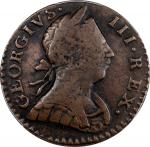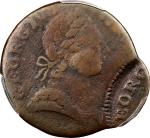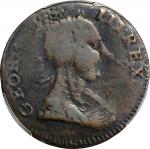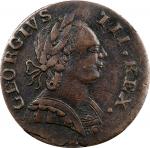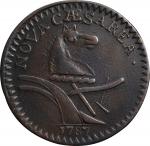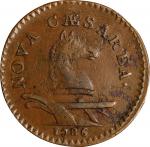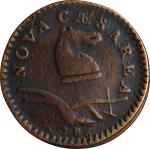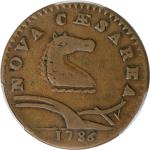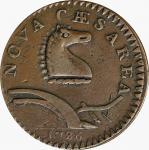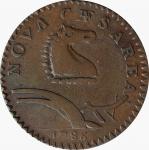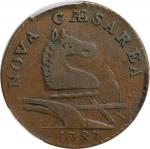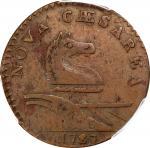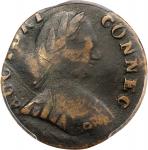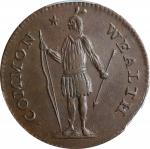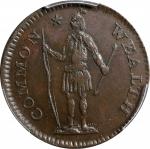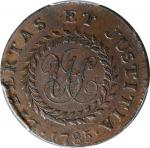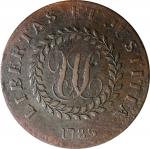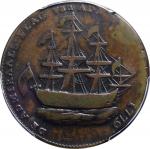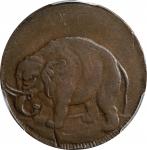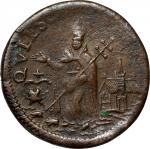1786 Non Vi Virtute Vici Copper. Musante GW-06, Baker-13C, Crosby-Unlisted, Breen-976, W-5720. Large Head. Copper. Plain Edge. VG-8 (PCGS). 28.0 mm. 164.4 grains. Mahogany-brown with a faint ruddy cast, while some of the higher points on the portrait and some of the obverse letters are deep tan. Mild porosity is noted over much of the surface. The dies were not properly aligned in striking this piece, and the planchet itself may have been a bit uneven. On the obverse, though the die seems to have been well centered, the detail toward 12 oclock is weak, and the head of the portrait seems to be distorted by some double striking most evident along the forehead. On the reverse, there is softness near 12 oclock as well, with the upper body and head of the figure obscured. This also relates to a network of natural shallow planchet fissures in this area that did not strike out, as well as the aforementioned misalignment that resulted in the reverse design being shifted in this general direction. In opposition of this area, the reverse rim is very wide, with bold sawtooth dentils well formed. Similarly, the date is sharp. Two small voids near the center of the reverse are also likely original to the flan. One blunt old scratch is noted in the lower portrait on the obverse, but is only a minor distraction.<p>As Michael Hodder wrote in his introduction to this series in our (Stacks) Ford II Sale, "The Non Vi Virtute Vici coppers of 1786 are collected both as Washingtoniana and as New York colonials." However, no one knows for sure what was intended by the maker, or who that maker even was. Baker listed them as Washington pieces based on his analysis of the obverse legend, but also noted that others collected them as New York issues. Hodder concluded that, "It seems safest to go with what is sure about the coin, found in its reverse legend, Neo-Eboracensis which means New York, and include the Non Vi Virtute Vici coppers in the New York colonial series."<p>As noted above, there remains uncertainty as to who made these, and even when. James Atlee has been the longest pointed-to maker, and Breen wrote in 1979 that these were struck by March 1786 based on lines published in a contemporary publication on March 29th of that year, which he believed referenced these coins. However, the noted passages included no description that could be certifiably identified as these coins, though the possibility remains. Three Non Vi types are known from seven dies: the Unique Non Vi Large Head-New Jersey Shield reverse; the 1786 Small Head Non Vi; and the 1786 Large Head Non Vi, as offered here. As Hodder wrote, this "is a remarkable number [of dies] considering that the total population of all known survivors is not higher than 40 coins" and there is almost no intermarriage between them save for a lone small head coin somewhat recently discovered with a previously unknown reverse. To Hodder, this suggested that these were "three distinct issues" perhaps even issued from more than one mint, by two to three different engravers. Breens more complex assessments of makers relies heavily on matching punch styles, which is unreliable, but not necessarily wrong.<p>Among the few things we known for sure is that the Non Vi Virtute Coppers are fairly well made, they have been long desired, and they are very rare. In the case of the present type, just two have ever been identified, this being the discovery specimen first appearing in 1890.<p>In the Ford sale, Hodder commented on this rare variant:<p><em>"The 1786 dated Large Head type is a well executed pair of dies. The portrait side shows embellishments in the uniform and neckband that only a skillful engraver could accomplish on such a small module. Likewise, the reverse figure of Commerce or Columbia or even New York is well drawn and the design of this die is decently balanced. It closely resembles the 1785 Immune Columbia type but whether it copied the type is debatable. Both of the surviving specimens are on round flans."</em><p>In his description of the superb Ford specimen, he referenced the two known, identifying the second as, simply, "the Parmelee:450 piece graded Fair at the time" without any further discussion of appearances or ownership. The Ford Specimen is by far the finer of the two, and sold to Donald Partrick for $218,500.<p>In the Heritage description of the same piece when selling the Partrick holdings, the second one was mentioned with similar scant detail, identifying it as ex Parmelee in 1890, but adding that it "eventually made its way to the Fuld Collection." When Q. David Bowers addressed the variety in his <em>Whitman Encyclopedia of Colonial and Early American Coins, </em>he offered that two were known, "Fords About Uncirculated and Parmelees coin called Fair in 1890, perhaps todays Good or Very Good." It seems as though no one had seen this piece, the discovery coin, in a very long time.<p>However, it was referenced by Walter Breen in 1978 correspondence with Eric Newman, and noted by him as having been lost in the mail. There is no indication given as to the timing or outcome of that event, and Breen would not necessarily have been advised of any resolution. He did comment in his letter that George Fuld might have an image of the coin. It would seem that Breen was correct about that, as Fuld had owned the coin, confirmed by Fuld himself when he wrote of it and plated it in his October 1995 COAC paper, "<em>Coinage Featuring George Washington." </em>It was clearly identified as the Parmelee specimen therein, as well as the "discovery piece" and one of just two known. For decades it has been off the radar of most modern collectors and researchers, identified as a rarity, but sitting with little other fanfare in a small Ohio collection.<p>Its appearance here is the first auction offering of this coin since the Parmelee sale in 1890, a remarkable return to the market of a great early American numismatic rarity. With the only other one being a superb piece, virtually the stuff of legend, with a commensurate price tag, this appearance represents the most accessible offering of this rare variety in 132 years, and it comes with an excellent provenance to one of Americas greatest 19th century collectors. PCGS# 421. Ex Lorin G. Parmelee Collection; New York Stamp and Coins sale of the Parmelee Collection, June 1890, lot 450; "McComb" (possibly George T. McComb, a dealer in Lockport, NY, listed in Robert Mercers Numismatic Directory for 1884); New Netherlands Coin Company; George Fuld; Richard Picker.

